Reducing Construction Dust Pollution by Planning Construction Site Layout
Abstract
:1. Introduction
2. Methodology
2.1. Determine the Scope of Study
2.2. Modeling of Multi-Objective Construction Site Layout Problems
2.2.1. Minimize the Impact of Construction Dust on Workers
2.2.2. Minimize the Total Transportation Cost
2.3. Constraints of the Construction Site Layout Problem
2.3.1. Construction Site Boundary Constraint
2.3.2. Overlapping and Safety Constraint
2.4. Optimization Using MOPSO Algorithm
Procedure of MOPSO Algorithm
3. Case Study
3.1. Case Study Description
3.2. Results of the Case Study
3.3. Result Analysis
4. Discussion
4.1. Theoretical Implications
4.2. Practical Implications
4.3. Limitations and Future Directions
5. Conclusions
Author Contributions
Funding
Informed Consent Statement
Data Availability Statement
Conflicts of Interest
References
- Yang, J.; Shi, B.; Shi, Y.; Marvin, S.; Zheng, Y.; Xia, G. Air pollution dispersal in high density urban areas: Research on the triadic relation of wind, air pollution, and urban form. Sustain. Cities Soc. 2020, 54, 101941. [Google Scholar] [CrossRef]
- Apte, J.S.; Brauer, M.; Cohen, A.J.; Ezzati, M.; Pope, C.A., III. Ambient PM2. 5 reduces global and regional life expectancy. Environ. Sci. Technol. Lett. 2018, 5, 546–551. [Google Scholar] [CrossRef] [Green Version]
- Li, C.Z.; Zhao, Y.; Xu, X. Investigation of dust exposure and control practices in the construction industry: Implications for cleaner production. J. Clean. Prod. 2019, 227, 810–824. [Google Scholar] [CrossRef]
- Tong, R.; Cheng, M.; Zhang, L.; Liu, M.; Yang, X.; Li, X.; Yin, W. The construction dust-induced occupational health risk using Monte-Carlo simulation. J. Clean. Prod. 2018, 184, 598–608. [Google Scholar] [CrossRef]
- Yan, H.; Ding, G.; Li, H.; Wang, Y.; Zhang, L.; Shen, Q.; Feng, K. Field Evaluation of the Dust Impacts from Construction Sites on Surrounding Areas: A City Case Study in China. Sustainability 2019, 11, 1906. [Google Scholar] [CrossRef] [Green Version]
- Brown, T. Silica exposure, smoking, silicosis and lung cancer-025EFcomplex interactions. Occup. Med. Oxf. 2009, 59, 89–95. [Google Scholar] [CrossRef] [PubMed] [Green Version]
- Meo, S.A.; Al-Drees, A.M.; Al Masri, A.A.; Al Rouq, F.; Azeem, M.A. Effect of Duration of Exposure to Cement Dust on Respiratory Function of Non-Smoking Cement Mill Workers. Int. J. Environ. Res. Public Health 2013, 10, 390–398. [Google Scholar] [CrossRef] [Green Version]
- Ngoc, L.T.N.; Park, D.; Lee, Y.I.; Lee, Y.-C. Systematic Review and Meta-Analysis of Human Skin Diseases Due to Particulate Matter. Int. J. Environ. Res. Public Health 2017, 14, 1458. [Google Scholar] [CrossRef] [Green Version]
- Kowalska, M.; Skrzypek, M.; Kowalski, M.; Cyrys, J.; Ewa, N.; Czech, E. The Relationship between Daily Concentration of Fine Particulate Matter in Ambient Air and Exacerbation of Respiratory Diseases in Silesian Agglomeration, Poland. Int. J. Environ. Res. Public Health 2019, 16, 1131. [Google Scholar] [CrossRef] [Green Version]
- Lim, C.C.; Hayes, R.B.; Ahn, J.; Shao, Y.; Silverman, D.T.; Jones, R.R.; Garcia, C.; Thurston, G.D. Association between long-term exposure to ambient air pollution and diabetes mortality in the US. Environ. Res. 2018, 165, 330–336. [Google Scholar] [CrossRef]
- Bergdahl, I.A.; Torén, K.; Eriksson, K.; Hedlund, U.; Nilsson, T.; Flodin, R.; Järvholm, B. Increased mortality in COPD among construction workers exposed to inorganic dust. Eur. Respir. J. 2004, 23, 402–406. [Google Scholar] [CrossRef] [PubMed] [Green Version]
- Borup, H.; Kirkeskov, L.; Hanskov, D.J.A.; Brauer, C. Systematic review: Chronic obstructive pulmonary disease and construction workers. Occup. Med. 2017, 67, 199–204. [Google Scholar] [CrossRef] [PubMed] [Green Version]
- Chen, X.; Guo, C.; Song, J.; Wang, X.; Cheng, J. Occupational health risk assessment based on actual dust exposure in a tunnel construction adopting roadheader in Chongqing, China. Build. Environ. 2019, 165, 106415. [Google Scholar] [CrossRef]
- Luo, Q.M.; Huang, L.P.; Xue, X.Y.; Chen, Z.S.; Zhou, F.B.; Wei, L.H.; Hua, J.M. Occupational health risk assessment based on dust exposure during earthwork construction. J. Build. Eng. 2021, 44, 103186. [Google Scholar] [CrossRef]
- Xing, Y.-F.; Xu, Y.-H.; Shi, M.-H.; Lian, Y.-X. The impact of PM2.5 on the human respiratory system. J. Thorac. Dis. 2016, 8, E69–E74. [Google Scholar] [CrossRef]
- Orru, H.; Maasikmets, M.; Lai, T.; Tamm, T.; Kaasik, M.; Kimmel, V.; Orru, K.; Merisalu, E.; Forsberg, B. Health impacts of particulate matter in five major Estonian towns: Main sources of exposure and local differences. Air Qual. Atmos. Health 2011, 4, 247–258. [Google Scholar] [CrossRef]
- Murray, C.J. Quantifying the burden of disease: The technical basis for disability-adjusted life years. Bull. World Health Organ. 1994, 72, 429. [Google Scholar]
- Yan, H.; Ding, G.; Feng, K.; Zhang, L.; Li, H.; Wang, Y.; Wu, T. Systematic evaluation framework and empirical study of the impacts of building construction dust on the surrounding environment. J. Clean. Prod. 2020, 275, 122767. [Google Scholar] [CrossRef]
- Othman, M.; Latif, M.T.; Mohamed, A.F. The PM10 compositions, sources and health risks assessment in mechanically ventilated office buildings in an urban environment. Air Qual. Atmos. Health 2016, 9, 597–612. [Google Scholar] [CrossRef]
- Azarmi, F.; Kumar, P.; Marsh, D.; Fuller, G. Assessment of the long-term impacts of PM10 and PM2.5 particles from construction works on surrounding areas. Environ. Sci. Processes Impacts 2016, 18, 208–221. [Google Scholar] [CrossRef] [Green Version]
- Zhang, B.; Jiao, L.; Xu, G.; Zhao, S.; Tang, X.; Zhou, Y.; Gong, C. Influences of wind and precipitation on different-sized particulate matter concentrations (PM2.5, PM10, PM2.5–10). Meteorol. Atmos. Phys. 2018, 130, 383–392. [Google Scholar] [CrossRef]
- Hojaiji, H.; Kalantarian, H.; Bui, A.A.T.; King, C.E.; Sarrafzadeh, M. Temperature and Humidity Calibration of a Low-Cost Wireless Dust Sensor for Real-Time Monitoring. In Proceedings of the 2017 IEEE Sensors Applications Symposium (SAS), Glassboro, NJ, USA, 13–15 March 2017; pp. 1–6. [Google Scholar]
- Jayaratne, R.; Liu, X.; Thai, P.; Dunbabin, M.; Morawska, L. The influence of humidity on the performance of a low-cost air particle mass sensor and the effect of atmospheric fog. Atmos. Meas. Tech. 2018, 11, 4883–4890. [Google Scholar] [CrossRef] [Green Version]
- Amato, F.; Pandolfi, M.; Moreno, T.; Furger, M.; Pey, J.; Alastuey, A.; Bukowiecki, N.; Prevot, A.S.H.; Baltensperger, U.; Querol, X. Sources and variability of inhalable road dust particles in three European cities. Atmos. Environ. 2011, 45, 6777–6787. [Google Scholar] [CrossRef]
- Cheriyan, D.; Choi, J.-H. A review of research on particulate matter pollution in the construction industry. J. Clean. Prod. 2020, 254, 120077. [Google Scholar] [CrossRef]
- Budde, M.; El Masri, R.; Riedel, T.; Beigl, M. Enabling Low-Cost Particulate Matter Measurement for Participatory Sensing Scenarios. In Proceedings of the 12th International Conference on Mobile and Ubiquitous Multimedia, Lulea, Sweden, 2–5 December 2013; pp. 1–10. [Google Scholar]
- Cheriyan, D.; Choi, J.-H. Estimation of particulate matter exposure to construction workers using low-cost dust sensors. Sustain. Cities Soc. 2020, 59, 102197. [Google Scholar] [CrossRef]
- Tjoe Nij, E.; Hilhorst, S.; Spee, T.; Spierings, J.; Steffens, F.; Lumens, M.; Heederik, D. Dust control measures in the construction industry. Ann. Occup. Hyg. 2003, 47, 211–218. [Google Scholar] [CrossRef] [PubMed] [Green Version]
- Wu, Z.; Zhang, X.; Wu, M. Mitigating construction dust pollution: State of the art and the way forward. J. Clean. Prod. 2016, 112, 1658–1666. [Google Scholar] [CrossRef]
- Hammad, A.W.A.; da Costa, B.B.F.; Soares, C.A.P.; Haddad, A.N. The Use of Unmanned Aerial Vehicles for Dynamic Site Layout Planning in Large-Scale Construction Projects. Buildings 2021, 11, 602. [Google Scholar] [CrossRef]
- Wang, J.; Zhang, X.; Shou, W.; Wang, X.; Xu, B.; Kim, M.J.; Wu, P. A BIM-based approach for automated tower crane layout planning. Autom. Constr. 2015, 59, 168–178. [Google Scholar] [CrossRef]
- Hsieh, N.-H.; Liao, C.-M. Assessing exposure risk for dust storm events-associated lung function decrement in asthmatics and implications for control. Atmos. Environ. 2013, 68, 256–264. [Google Scholar] [CrossRef]
- USEPA. Risk Assessment Guidance for Superfund Volume I: Human Health Evaluation Manual (Part F, Supplemental Guidance for Inhalation Risk Assessment, EPA-540-R-070–002); U.S. Environmental Protection Agency: Washington, DC, USA, 2009.
- Breckling, J. The Analysis of Directional Time Series: Applications to Wind Speed and Direction; Springer Science & Business Media: Berlin/Heidelberg, Germany, 2012; Volume 61. [Google Scholar]
- Eltayeb, I.A.; Hassan, M.H.A. Diffusion of dust particles from a point source above ground level and a line source at ground level. Geophys. J. Int. 2000, 142, 426–438. [Google Scholar] [CrossRef] [Green Version]
- Liu, W.; Yuan, Z.; Hu, W.; Wang, Y. Spatial diffusion characteristics and hierarchical control measures of construction dust. Chin. J. Environ. Eng. 2021, 15, 1976–1987. [Google Scholar] [CrossRef]
- Ning, X.; Qi, J.; Wu, C.; Wang, W. Reducing noise pollution by planning construction site layout via a multi-objective optimization model. J. Clean. Prod. 2019, 222, 218–230. [Google Scholar] [CrossRef]
- Kumar, S.S.; Cheng, J.C.P. A BIM-based automated site layout planning framework for congested construction sites. Autom. Constr. 2015, 59, 24–37. [Google Scholar] [CrossRef]
- Xu, J.; Song, X. Multi-objective dynamic layout problem for temporary construction facilities with unequal-area departments under fuzzy random environment. Knowl. Based Syst. 2015, 81, 30–45. [Google Scholar] [CrossRef]
- Hammad, A.W.A.; Akbarnezhad, A.; Rey, D. A multi-objective mixed integer nonlinear programming model for construction site layout planning to minimise noise pollution and transport costs. Autom. Constr. 2016, 61, 73–85. [Google Scholar] [CrossRef]
- Coello, C.A.C.; Pulido, G.T.; Lechuga, M.S. Handling multiple objectives with particle swarm optimization. IEEE Trans. Evol. Comput. 2004, 8, 256–279. [Google Scholar] [CrossRef]
- Deb, K. Multi-Objective Optimisation using Evolutionary Algorithms: An Introduction. In Multi-Objective Evolutionary Optimisation for Product Design and Manufacturing; Springer: Berlin/Heidelberg, Germany, 2011; pp. 3–34. [Google Scholar]
- Xu, C.; Nie, W.; Liu, Z.; Peng, H.; Yang, S.; Liu, Q. Multi-factor numerical simulation study on spray dust suppression device in coal mining process. Energy 2019, 182, 544–558. [Google Scholar] [CrossRef]
- Guo, C.; Nie, W.; Xu, C.; Peng, H.; Zhang, C.; Li, S.; Yue, N.; Liu, Z.; Yang, S.; Ma, Q.; et al. A study of the spray atomization and suppression of tunnel dust pollution based on a CFD-based simulation. J. Clean. Prod. 2020, 276, 123632. [Google Scholar] [CrossRef]
- Zhou, G.; Zhang, Q.; Bai, R.; Fan, T.; Wang, G. The diffusion behavior law of respirable dust at fully mechanized caving face in coal mine: CFD numerical simulation and engineering application. Process Saf. Environ. Prot. 2017, 106, 117–128. [Google Scholar] [CrossRef]
- Kinsey, J.S.; Linna, K.J.; Squier, W.C.; Muleski, G.E.; Cowherd, C., Jr. Characterization of the fugitive particulate emissions from construction mud/dirt carryout. J. Air Waste Manag. Assoc. 2004, 54, 1394–1404. [Google Scholar] [CrossRef] [PubMed] [Green Version]
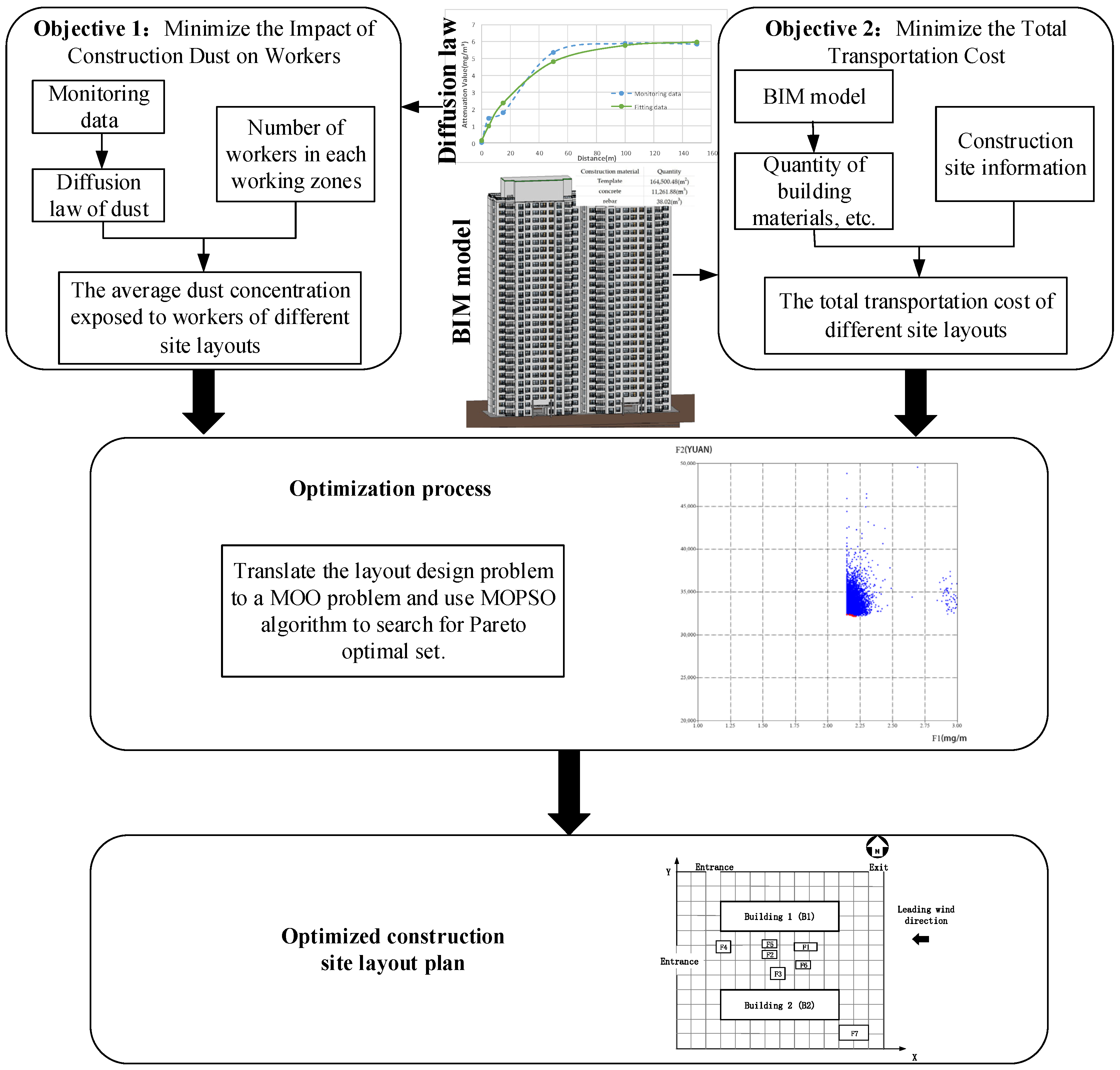
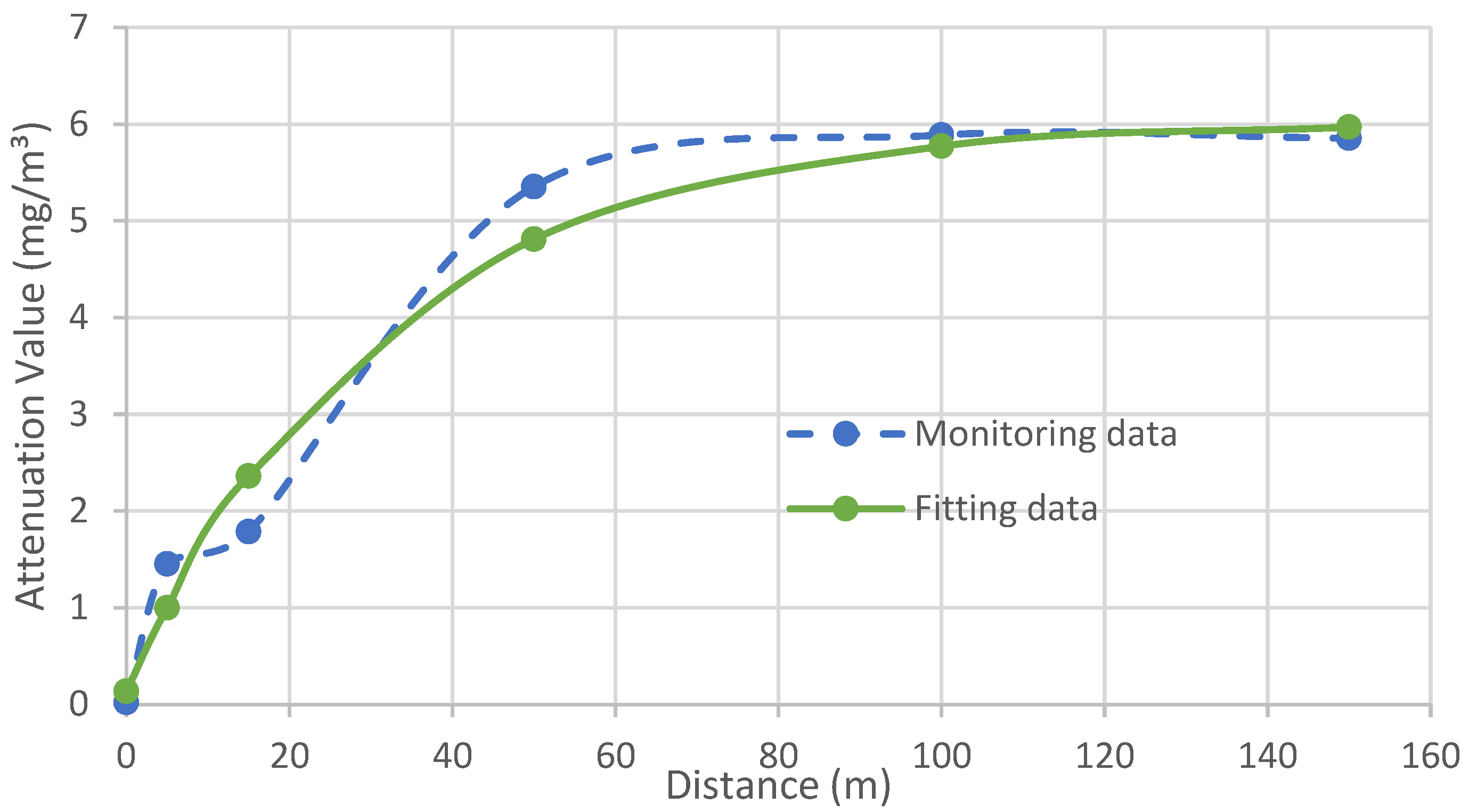
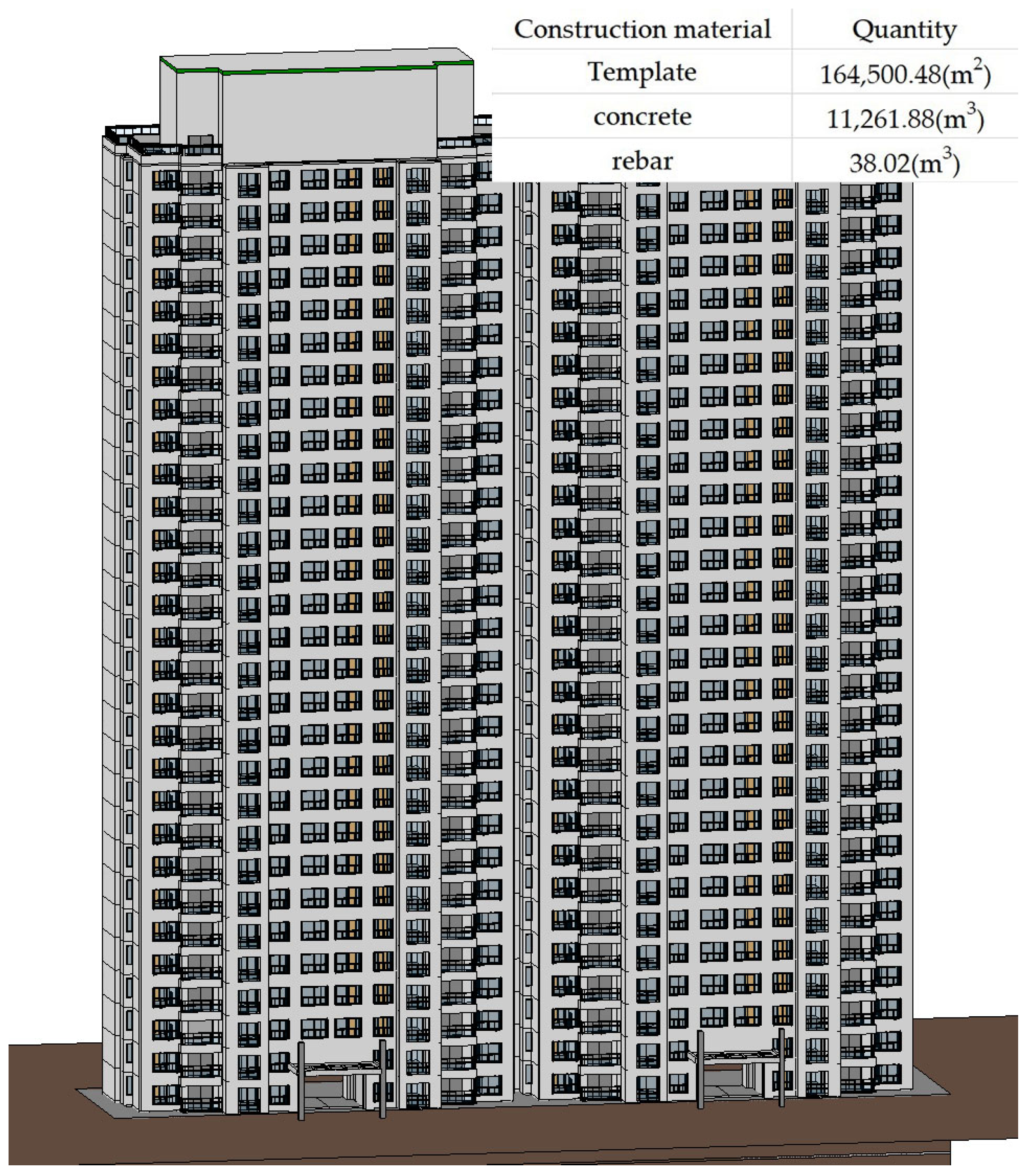
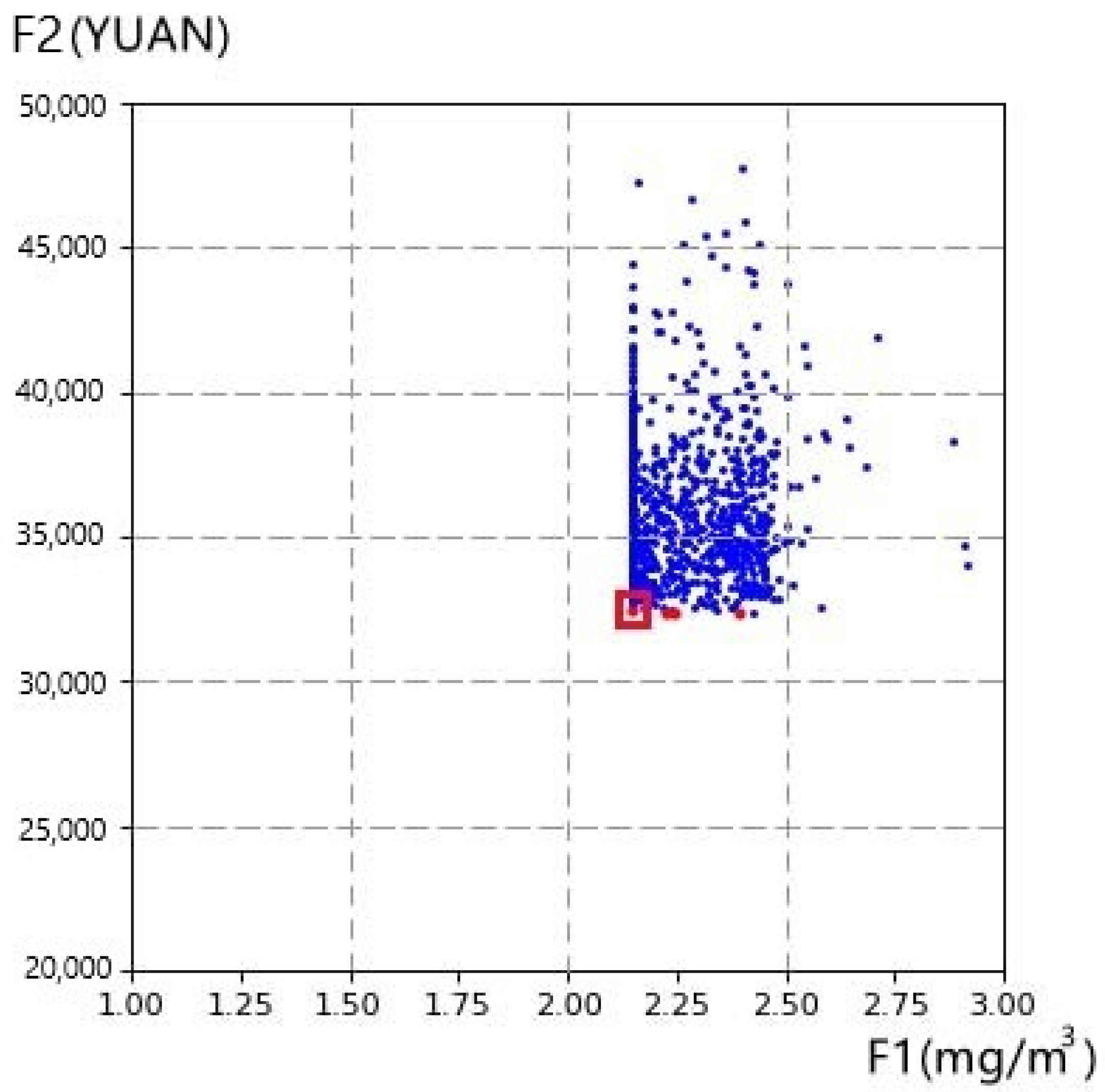
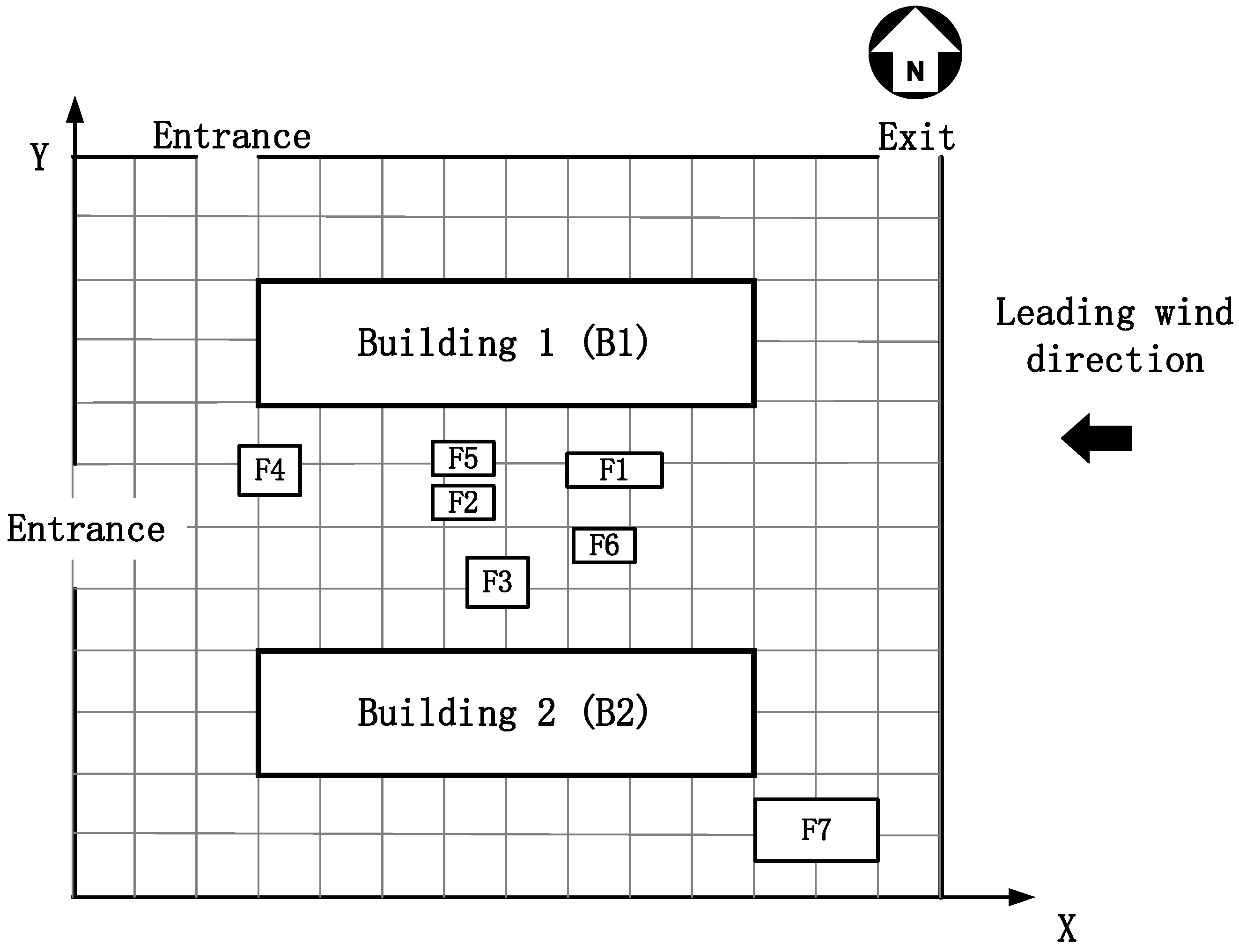
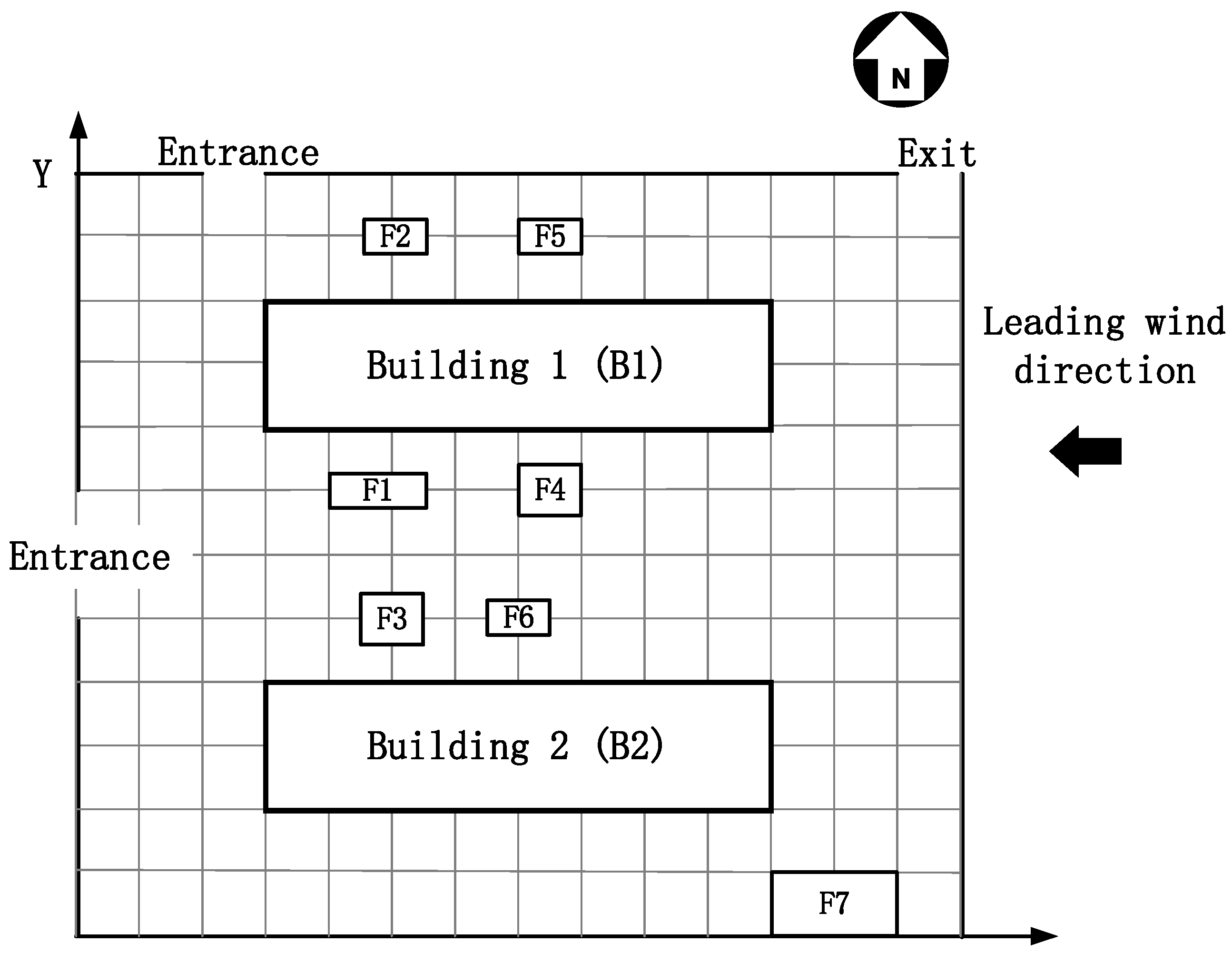
| Symbol | Facility | Type | Width in x Direction (m) | Length in y Direction (m) |
|---|---|---|---|---|
| F1 | Template storage yard | Storage | 15 | 5 |
| F2 | Rebar storage yard | Storage | 10 | 5 |
| F3 | Concrete warehouse | Storage | 10 | 8 |
| F4 | Template processing yard | Processing | 10 | 8 |
| F5 | Rebar processing yard | Processing | 10 | 5 |
| F6 | Concrete mixing station | Processing | 10 | 5 |
| F7 | Site office | Residence | 20 | 10 |
| Symbol | Workspace | Number of Workers Required |
|---|---|---|
| F4 | Template processing yard | 5 |
| F5 | Rebar processing yard | 10 |
| F6 | Concrete mixing station | 5 |
| F7 | Site office | 10 |
| B1/B2 | Floor zone | 20 1 |
| Symbol | Dust Source | Corresponding Construction Activity | Dust Concentration (mg/m3) |
| F4 | Template processing yard | Template processing | 5.65 |
| F5 | Rebar processing yard | Rebar cutting and bending | 1.50 |
| F6 | Concrete mixing station | Concrete mixing | 2.24 |
| B1/B2 | Floor zone | Concrete pouring, template dismantling, etc. | 1.20 |
| Construction Site Layout Plan | Objective Functions | |
|---|---|---|
| F1 (mg/m3) | F2 (yuan) | |
| Original CSLP | 5.46 | 57,129.62 |
| Optimized CSLP | 2.15 | 31,819.56 |
Publisher’s Note: MDPI stays neutral with regard to jurisdictional claims in published maps and institutional affiliations. |
© 2022 by the authors. Licensee MDPI, Basel, Switzerland. This article is an open access article distributed under the terms and conditions of the Creative Commons Attribution (CC BY) license (https://creativecommons.org/licenses/by/4.0/).
Share and Cite
Tao, G.; Feng, J.; Feng, H.; Feng, H.; Zhang, K. Reducing Construction Dust Pollution by Planning Construction Site Layout. Buildings 2022, 12, 531. https://doi.org/10.3390/buildings12050531
Tao G, Feng J, Feng H, Feng H, Zhang K. Reducing Construction Dust Pollution by Planning Construction Site Layout. Buildings. 2022; 12(5):531. https://doi.org/10.3390/buildings12050531
Chicago/Turabian StyleTao, Guowu, Jingchun Feng, Haibo Feng, Hui Feng, and Ke Zhang. 2022. "Reducing Construction Dust Pollution by Planning Construction Site Layout" Buildings 12, no. 5: 531. https://doi.org/10.3390/buildings12050531





